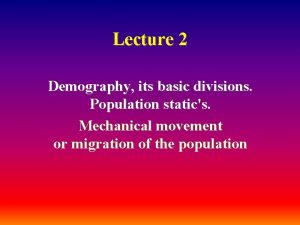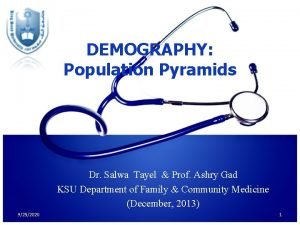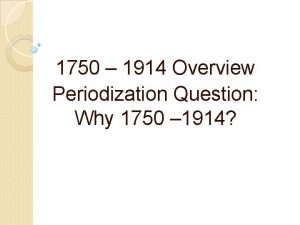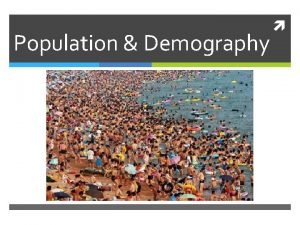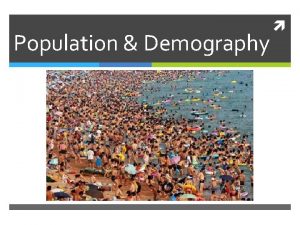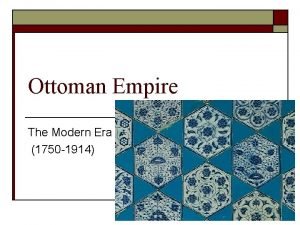MODERN ERA 1750 1914 DEMOGRAPHY AND THE ENVIRONMENT













- Slides: 13

MODERN ERA: 1750 - 1914 DEMOGRAPHY AND THE ENVIRONMENT IN AN AGE OF REVOLUTION AND INDUSTRIALIZATION

DEMOGRAPHIC TRANSITION Malthusian Economics Predicted human population always outpaced food, supplies Only natural disasters, wars, famine keep population low Did not figure in technology, inventions, science Key Characteristics Population • Increased from 900 million (1800) to 1. 6 billion (1900) • In Europe, Asia, North America • Scientific, medical advances – Increase life span, infant survival rate – Decrease death rate, death of mother during childbirth – New hygiene Food supply increases • • Lightly, uninhabited areas brought under cultivation World trade allows for foods to reach areas quicker Staples in world trade due to refrigeration, canning, ships Agronomy, animal husbandry increase yields, variety, quality – Fruits of the Columbian Exchange – Many nations begin to export quantities of wheat, meat Population Movements • Internal Migration to unsettled lands, international Migrations • Urbanization • End of Slave Trade necessitated labor based migration

GRAPHING MALTHUS & DEMOGRAPHIC TRANSITION

2 ND AGRICULTURAL REVOLUTION In 1750 the world was largely subsistence agriculture Rhythms of regional agricultural societies based on seasons, surroundings Small plots, rural villages, no export: exception were Russia, Baltic Began in England but also occurred in Western Europe, US, Asia Outgrowth of Columbian Exchange Outgrowth of the Scientific Revolution Enclosure Act Larger landowners begin to enclose lands • • Began with enclosure of public lands Done legally to increase yields of large landowners Then took smaller farms, plots away from poor farmers Done with support of Parliament Results • Moved small, inefficient farms into better productivity • Brought new lands under cultivation • Freed labor factories and swelled population in cities The Revolution New Foodstuffs planted; new styles of crop rotations Selected breeds of cattle, dairy cattle, sheep Technology, science applied to farming Agricultural Revolution followed European imperialism Europeans brought their crops, animals with them Europeans began exploiting cash crops for commercial profit abroad

FROM PEASANTS TO FARMERS The process, while social, began with technology, science Agronomy and animal husbandry replaced herding • Selective breeding, splicing, experimentation • Crop varieties, fertilizers to enrich soil Farming machinery introduced • Thrashers, reapers, seed drills, tractors • Muscle , animal power replaced by machines • Barbed wire was a revolution Transport, preservation made export possible • Trains, ships with large holds • Grain silos, refrigerator ships, canning, food processors Subsistence Agriculture becomes commercial farming Western Europe, US, Canada, Argentina, Brazil, Uruguay Australia, New Zealand, parts of India, China, Japan On the other hand, in some countries Peasants went from masters of their own work To hands for someone else’s work, or someone else’s work hands Russia, Eastern Europe, Africa, parts of Latin America, SE Asia

COMMERCIAL AGRICULTURE Commercial agriculture was a revolution 1750 – 1914 Cash crops: crops grown for profitable export Often luxuries or non-necessities with high profit margins Two bottlenecks (natural hindrance to profitable production) • Many are labor intensive: solution – slavery, paid agricultural workers • Many require extensive processing, preservation to be useful: solution – technology Commercial agriculture is heavily damaging to the environment, soil First arose during 16 th century colonialism Caribbean, Brazilian, SE Asian plantations Latin American haciendas, rancheros First export crops: sugar, hides, wool, spices Expanded in 18 th century British North American colonies added tobacco, indigo, rice Asia added tea, coffee, opium, cloves Americas added cocoa, coffee Industrial Revolution made additional possible more Cotton (seeds); rubber, oil (synthesizing) Beef, mutton, grains, dairy (long-term preservation, get to market on time) The rest of world, especially Africa enormously effected Many areas of world taken from feeding people to exporting for profit

POPULATION GROWTH The Fruits of Industry Industrialization raised material standards of living • • Mass production made luxuries into common goods Workers received pay and able to buy goods, foods • • • Reduced death rate of adults and children Reduced deaths due to childbirth Increased life span Decreased infant mortality Declining birthrate in response to declining mortality Voluntary birth control through contraception • • Populations of Europe, America, Asia rose sharply from 1700 to 1900 Increasing urbanization especially of port cities, industrial cities Better diets and improved sanitation Impact on Population World Effects Change typical of industrialized countries Change confined to port cities of non-Western nations

DOMESTIC MIGRATION Industrialization Drew migrants from countryside to urban centers By 1900, In Europe and Anglo-North America • • 50 percent of population of industrialized nations lived in towns More than 150 cities with over 100, 000 people • • Shoddy houses, fouled air, inadequate water By late 19 th century Urban problems – – Governments passed legislation to clean up cities Passed building codes, built sewer systems Internal Migration Settlement of Frontiers by population centers • • Existing populations expand into plains, prairies Facilitated by railroads, technology • • • Westward Movement in USA, Canada, Australia Settlement of Siberia by Russia Great Trek by Afrikaaners Chinese settlement of Yangtze, west, Manchuria Settlement of Brazilian, Argentine interior plains Examples

TRANSCONTINENTAL IMMIGRATION Reasons for immigration Factors pushing people to immigrate • • Failed revolutions, nationalisms led losers, minorities to immigrate Severe economic, social conditions, repressions in Italy, Slavic lands Overpopulation drove many to immigrate Contract labor immigration in India, China, Indonesia Factors pulling people to immigrate • Better economic opportunities abroad • Gold Rushes, free land, recruitment by settler nations Europe 1800 -1920 60 million Europeans migrated Canada, US, Chile, Brazil, Argentina in the Americas Settler colonies of South Africa, Australia, New Zealand Jews, Catholics transformed US through migration Asian Immigration Chinese Immigration • Businessmen allowed to settle in French, British port cities • Laborers exported across Pacific to do manual labor following abolition of slavery • Built American railroads in the West Indian, Southeast Asian laborers • Migrated to British, French African, Indian Ocean, British Caribbean, Asia-Pacific colonies • Used for heavy labor, household labor following abolition of slavery Korean laborers moved around Japanese Empire

MIGRATION TO THE AMERICAS Industrial migrants to United States and Canada • • • In 1850 s 2. 3 million Europeans migrated to US, Canada Mostly Irish, German, English Number increased after from 1870 s to 1920 s Immigrant labor replaced slave labor Contributed to U. S. industrial expansion Provided labor in factories, on railroads Union soldiers were 1/5 immigrants 1852 -1875 200, 000 Chinese migrated to California Worked in mines and building railroads Provided domestic labor in West 1875 – 1920 S. European: Italians, Greeks to USA E. European: Poles, Ukrainians, Czechs, Slovaks, Jews to US, Canada N. European: Scandinavians to Canada Latin American • • Migrants mostly worked on agricultural plantations Italians migrated to South America – – Changed Chile, Uruguay, Argentina into Neo-Europes Profoundly remade Brazil into a multi-racial society (was African) Asians migrated to Cuba, Peru and the Caribbean sugar fields Migration to the cities in Mexico, Argentina, Brazil

MIGRATIONS DUE TO EMPIRE European migration • • • Fifty million Europeans migrated 1800 -1914, over half to the US Settler colonies in Canada, Argentina, Australia, New Zealand, S. Africa Most European migrants became cultivators, herders, skilled laborers Led to Dominion Status for Canada, S. Africa, Australia, New Zealand Britain, Russia UK: Canada, Australia, New Zealand Russia: Siberia South Africa British acquired South Africa from Dutch in 1815 Pressure led Boers to migrate to the interior Indentured labor, contract labor migration • • • Most from Asia, Africa, and Pacific islands 2. 5 million indentured laborers during 1820 -1914 Indentured migrants to work on plantations Example Indian laborers to Pacific island Caribbean plantations Japanese laborers to Hawaiian sugar plantations Chinese work on building railroads in US Chinese provide heavy lifting labor throughout French, British, US empires Other migrations Reflected global influence of imperialism Hindu merchants settled heavily in East Africa, S. Africa, Malaya Chinese merchants followed contract laborer to Pacific cities

ENVIRONMENTAL DEGREDATION First era in history when environment seriously threatened by humans Causes of Environmental Stress Industrialization • Pollution increased significantly especially in cities, water • Ability to destroy land for resources increased due to technology • Examples: Industrial areas of Western Europe, Eastern USA Technology • Iincreased production on land, from resources • Marginal lands could be settled, exploited Demographic Stress • • Urbanization, expanding cities destroyed habitats High Population Densities supported by food Many acres moved to unproductive status Examples: Western Europe, Asian/Indian port cities Environmental Shift • Farming, ranching changed face of landscape – – – Ranch animals introduced new fauna, diseases, threats Farming horticulture introduced new flora Examples: Americas, Australia, New Zealand, Africa, Hawaii • Switch from subsistence agriculture to commercial agriculture changed face of environment • Forests were the most effected by this shift Extinction, Endangerment of Flora, Fauna • • Overfishing of areas began, overforesting of areas Many died out due to competition from domestic flora, fauna Many were exterminated due to hunting: Passenger Pigeon, Dodo Examples: United States, Australia, New Zealand

ECOLOGICAL IMPERIALISM Europeans brought flora, fauna to their colonies Preferred European animals, crops; drove out native species Ecological imperialism worse in Australia, New Zealand New crops transformed landscape and society • • • • Westerners converted colonial landscape to export Wanted agriculture to be export, profit Converted farming land to use for export crops Destroyed centuries old farming systems to plant export crops Many lands could no longer feed the native population Plantations used paid, indentured native labor Colonial rule Transformed traditional production of crops and commodities Indian cotton grown to serve British textile industry Inexpensive imported textiles undermined Indian production Examples Rain forests of Ceylon converted to tea plantations Ceylonese women recruited to harvest tea Rubber plantations transformed Malaya and Sumatra Americans ran sugar, pineapple plantations in Pacific, Hawaii Planted coffee, banana trees in Africa, Americas US interests plant hemp in Yucatan for export Argentine, Brazilian grains, cattle take over Pampa, Mato Grosso
 Jacob pertl
Jacob pertl It is an era from 1750-1820
It is an era from 1750-1820 Static demography
Static demography Cso business demography
Cso business demography Elements of demography
Elements of demography Hotelling model ap human geography
Hotelling model ap human geography Demographic data definition
Demographic data definition Difference between a sample and a population
Difference between a sample and a population Components of demography
Components of demography Demography antonym
Demography antonym Quiz 2 the baroque era
Quiz 2 the baroque era Elizabethan vs victorian
Elizabethan vs victorian Creí que era una aventura y en realidad era la vida
Creí que era una aventura y en realidad era la vida Era uma estrela tão alta era uma estrela tão fria
Era uma estrela tão alta era uma estrela tão fria


